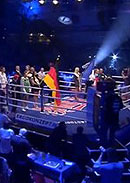|
| |
|
|
|
|
|
|
|
|
 |
AIBA agree on women Pros for Olympics
and changes in scoring and judging systems
by Michael O'Neill
December 7, 2016 |
|
|
|
|
|
|
(DEC 7) News just in from the
AIBA (International Boxing Association) that several important
changes have been made for 2017 and beyond. These changes are
designed to improve and clarify aspects of in-competition
procedures and scoring and have just been ratified by the AIBA
Executive Committee.
Among the most integral rule changes ready to be implemented at
tournaments in 2017 will be the use of the independent Swiss
Timing electronic draw system to select the Judges for each bout
and the use of all five of their scorecards to determine the
winner.
“Sport is always evolving, and AIBA continuously strives to
introduce changes that will help maintain boxing’s position as
one of the most exciting and popular sports in the world.
Proposals that our experts on the R&J and T&R Commissions put
forward in October have been provisionally agreed upon and
road-tested at the recent Youth World Championships in Saint
Petersburg. Following that operational success, these important
changes can now be introduced to all AOB competitions, and it is
satisfying to see the efficiency with which the process has been
conducted in such a short period of time,” said AIBA President
Dr Ching-Kuo Wu.
More solutions for R&J scoring comprehension:
The changes to the R&J procedure will provide further
transparency to the scoring process, with the Draw Commission
replaced by a single Commission Chairman to verify the
electronic selection by Swiss Timing. Judges will now be
positioned on the four sides of the ring rather than three, and
all five scorecards will be used to determine the winner. The
scores for each round will only be declared at the conclusion of
a bout rather than at the ends of the rounds, and the R&J
Evaluators are now formally recognised as International
Technical Official positions.
Refined four-year calendar approved:
Important changes to streamline and enhance the competition
calendar are approved in order to give greater emphasis to the
Continental Championships, reduce costs for NFs and give ITOs
more year-round opportunities. From 2019, the Men’s and Women’s
World Championships will fall in the same calendar year, with
the Men’s and Women’s Youth Championships scheduled for the year
before.
Door opened for professionals:
All National Federations have been informed of the full list of
rule changes in order to disseminate them to their members as
the next Olympic cycle gets underway for Tokyo 2020. It was
ahead of the Rio 2016 that the ground-breaking vote to allow
non-AIBA pro boxers to compete at the Olympic Games was made,
and that decision has now been taken to its natural conclusion,
with National Federations henceforth empowered to select from a
wider pool of boxers, including those from other organisations,
providing standard eligibility AIBA requirements are met”.
That last paragraph of course is of great important to women
boxers since a limited number of males but no females took part
in Rio 2016. Now it is open to more Pros to also try and qualify
for the Olympics via their National Federations or for example
via any WSB or APB bouts which may be authorised before the next
Games.
Since that last paragraph is open to interpretation ie: …”
providing standard eligibility AIBA requirements are met”, WBAN
has asked the AIBA to clarify same and specify the true meaning
especially as to whether or not boxers who have had more than a
certain number of Pro fights will be excluded. More on that when
we hear from the AIBA.
It does look now though has if the final decisions will rest
with the National Federations and NOT all may agree to include
Professionals.
Will we see such as Claressa Shields, Katie Taylor, and if they
turn Pro shortly as expected, Estelle Mossely and Nicola Adams
in Tokyo 2020?
|
|
|
|
| |
|
|
|
|
| |
|
|
|
|
| |
|
|
|
|
|
